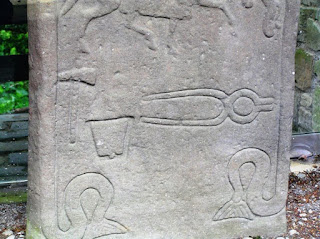THE SPIRITUALITY OF BLACKSMITHS - Susan Price
 | ||
| 'HEAD AND TALES' by Susan Price: cover by Andrew Price |
The first story in my new e-book collection of folk-legends, HEAD AND TALES, is ‘The Boy and The Blacksmith’.
In short, the story is of a blacksmith challenged to a trial of skill by the King’s goldsmith. On his way to the trial, the blacksmith meets ‘a raggedy navvy-boy’, who tags along with him.
Before the king and court, the blacksmith makes mundane horse-shoes, a scythe blade and a ploughshare – which will, he claims, ‘feed people’. The navvy-boy visits the goldsmith’s shop and reports that the goldsmith is making wondrous things – a living apple-tree, a living fish, a corn-wreath, all of gold.
With the boy’s help, the blacksmith creates an iron deer, which kills the gold tree; an iron otter, which eats the gold salmon; and an iron cockerel, which eats the gold wreath. ‘Iron is stronger than gold.’
The blacksmith wins the contest, and becomes the King’s smith. Later, the ‘navvy-boy’ returns and borrows the blacksmith’s forge to melt down three ‘sorry horses’ and re-forge them into one magnificent horse. The blacksmith attempts the same with the king’s horses, fails, and is thrown into jail to await execution.
He shares his cell with a sick man. The navvy-boy, carrying a cauldron and firewood, walks in through the wall. He builds a fire, and boils a cauldron of water, before cutting off the sick man’s head, boiling it in the pot, and sticking it back on the man’s head. The sick man is cured. The navvy boy leaves, and the recovered prisoner is pardoned and released shortly after.
The blacksmith, hearing the king is sick, offers to cure him, and tries the navvy boy’s ‘boil the head’ method. And fails. Luckily, the navvy boy turns up again, and cures the king – who grudgingly releases the blacksmith, providing he leaves the court immediately.
The navvy-boy accompanies the blacksmith on the road, and, to repay him, the blacksmith buys him shoes and gloves. While he’s putting the things on the boy, he notices that through each of the boy’s hands and feet are neat nail-holes.
What a story! Rereading it as I produced the e-book, I was taken aback by its power.
There is obvious religious imagery: the humble, ragged boy who is Christ, living on earth among the lowliest. The power of remaking, of resurrection, of giving life, lies only with Christ – or, you could say, with the Gods – and not with any man, however skilful.
But why a blacksmith? Why not a woodworker, a potter, a stone-carver? Of course, in the past, blacksmiths could be significant in their communities – skilled, physically strong, often prosperous. And they worked in open-sided forges where travellers came for repairs, bringing news with them, and where locals gathered for gossip. This may sufficiently explain why the story is about a blacksmith but is it merely fanciful to wonder if the story holds echoes of a time when smiths were considered magical?
 |
| 'Agamemnon's treasure'. |
Smiths took stone from the earth and, with fire, turned stone to a fiery liquid, which cooled into something new - metal.
Magic – alchemy! From those elemental things, earth and fire, they produced by secret ways – no doubt conducted with prayer and ritual – shining gold, silver, copper, tin, bronze and iron.
Working again with that mysterious and dangerous thing, fire, they shaped those lumps of metal into ploughs to feed people, blades to defend them, bright jewellery to adorn them.
It’s no coincidence that there are smiths among the gods: Hephaestus, Lugh, Weyland, Vulcan.
 |
| Leaf-shaped bronze sword |
The first metal swords, in the bronze age – beautiful leaf-shaped, gleaming, things – were not beaten on an anvil, but cast in stone moulds. Of dazzling rarity, power and status, they were possessions of kings. But whatever king wielded it, it was a smith who ‘drew the sword from the stone’.
A blacksmith’s tongs are found among the symbols on the mysterious and beautiful Pictish stones. A friend once dismissed the idea that these might have a religious significance ‘because there’s nothing religious about a pair of tongs.’
What’s religious about a mundane, despised method of execution in the Roman Empire? Yet, list what The Cross stands for today. Sacrifice – redemption – rebirth – everlasting life – hope – love – all meanings contained in two simple lines. Those with any education in Christianity understand this because they have the key to unlock the meaning.
 |
| Tongs on a Pictish stone |
We’ve lost beyond recovery the key to understanding the meaning of the Pictish stones. It may well be that, as my friend argued, the symbols are merely family badges, and the stones only territorial markers.
But it’s also possible that the blacksmith’s tongs once triggered memories, images and meanings as complex and layered as does the Christian cross. One of the symbols representing the Greek smith god Hephaestus was - a pair of blacksmith’s tongs.
The story of the Boy and the Blacksmith has, I think, yet another layer. The blacksmith stubbornly insists on making his iron tools, and yet, when prodded by the boy, he creates objects of delicacy and beauty. The blacksmith and the boy are artist and muse, consciousness and subconscious. Or, if you prefer, body and soul.
You may also enjoy this connected post - SPEAKING OF SEVERED HEADS
The book HEAD AND TALES is available for download.
Susan Price can also be found blogging at the Nennius blog here
And her website is here
The book HEAD AND TALES is available for download.
Susan Price can also be found blogging at the Nennius blog here
And her website is here

Comments
I am reminded of the Seamus Heaney poem, DOOR INTO THE DARK.
Great cover, too!